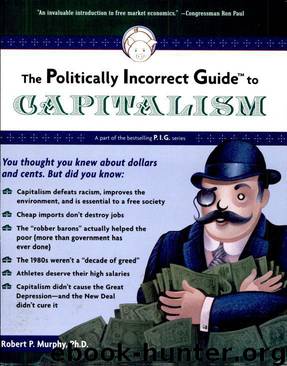The Politically Incorrect Guide to Capitalism by Murphy Robert P

Author:Murphy, Robert P [Murphy, Robert P]
Language: eng
Format: epub
Tags: Patriot Bookshelf
ISBN: 1596985046
Amazon: B002HRFPMW
Publisher: Regnery Publishing
Published: 2012-11-06T06:00:00+00:00
The business cycle: Courtesy of the government
Every year, some businesses thrive while others fail. In the normal operation of the market, successful entrepreneurs are rewarded with profits and growth, while unsuccessful businesses are penalized by losses and ultimately bankruptcy. Yet when we speak of the business cycle, we refer to the periodic rise and fall of business fortunes in general. The question isn't, "Why do some businesses need to lay off workers and scale back operations?" Rather, it is, "Why is it that sometimes most businesses realize their prior forecasts were overly optimistic?"
One view-held by theoretical Marxists as well as by laymen-holds that the business cycle is a natural outcome of the capitalist system. The problem with this explanation is that there is nothing to distinguish booms from busts. If free enterprise causes depressions, why did the worst one happen in the 1930s, rather than, say, the 1850s or the 1880s? Certainly the American market was just as "wildcat" in those earlier decades.
A different view holds that government intervention in the monetary and banking system causes the business cycle. Within this broad category we can distinguish between the monetarist theory, as exemplified by Milton Friedman, versus the Austrian theory, as developed by Ludwig von Mises and Friedrich Hayek. Although this book is not the place to evaluate the merits and weaknesses of these rival interpretations, a brief summary will underscore the claim that the Great Depression (and business cycles in general) was not the fault of the free market.
The monetarist view (explained for the layman in Friedman's Capitalism and Freedom) holds that the government ought to maintain a slow and constant growth in the money supply. Such predictability would reassure the financial markets and lead to smoother, steadier growth in real output. In contrast, the actual policies of the Federal Reserve almost defy belief. In the panicky three years after the great crash in 1929, the Fed responded by cutting the money supply by almost one-third! Is it any wonder, according to Friedmanites, that this general downturn was deeper and more prolonged than previous ones in U.S. history?
Download
This site does not store any files on its server. We only index and link to content provided by other sites. Please contact the content providers to delete copyright contents if any and email us, we'll remove relevant links or contents immediately.
| Anarchism | Communism & Socialism |
| Conservatism & Liberalism | Democracy |
| Fascism | Libertarianism |
| Nationalism | Radicalism |
| Utopian |
The Secret History by Donna Tartt(16703)
The Social Justice Warrior Handbook by Lisa De Pasquale(11501)
Thirteen Reasons Why by Jay Asher(7823)
This Is How You Lose Her by Junot Diaz(5814)
Weapons of Math Destruction by Cathy O'Neil(5067)
Zero to One by Peter Thiel(4855)
The Myth of the Strong Leader by Archie Brown(4804)
Promise Me, Dad by Joe Biden(4467)
Beartown by Fredrik Backman(4457)
How Democracies Die by Steven Levitsky & Daniel Ziblatt(4438)
Stone's Rules by Roger Stone(4433)
The Fire Next Time by James Baldwin(4362)
100 Deadly Skills by Clint Emerson(4102)
A Higher Loyalty: Truth, Lies, and Leadership by James Comey(4049)
Rise and Kill First by Ronen Bergman(4036)
The David Icke Guide to the Global Conspiracy (and how to end it) by David Icke(3905)
The Farm by Tom Rob Smith(3888)
Secrecy World by Jake Bernstein(3800)
The Doomsday Machine by Daniel Ellsberg(3746)
